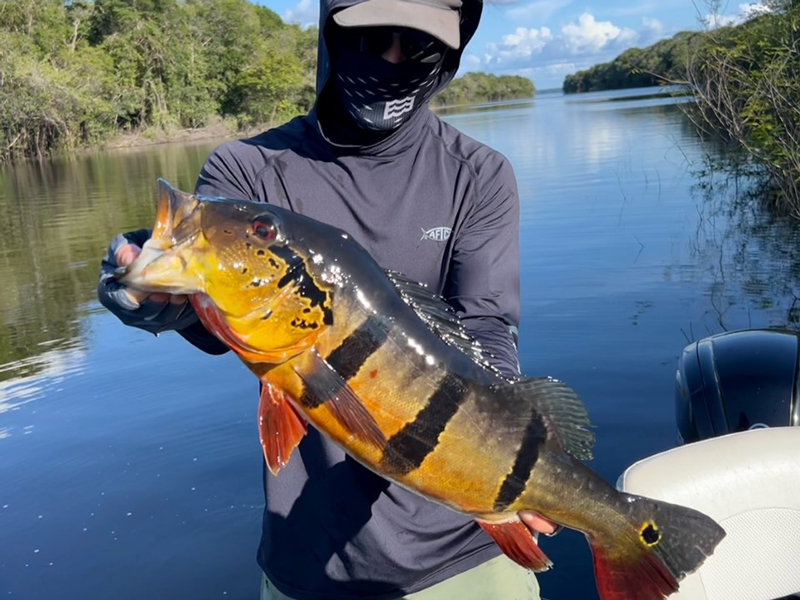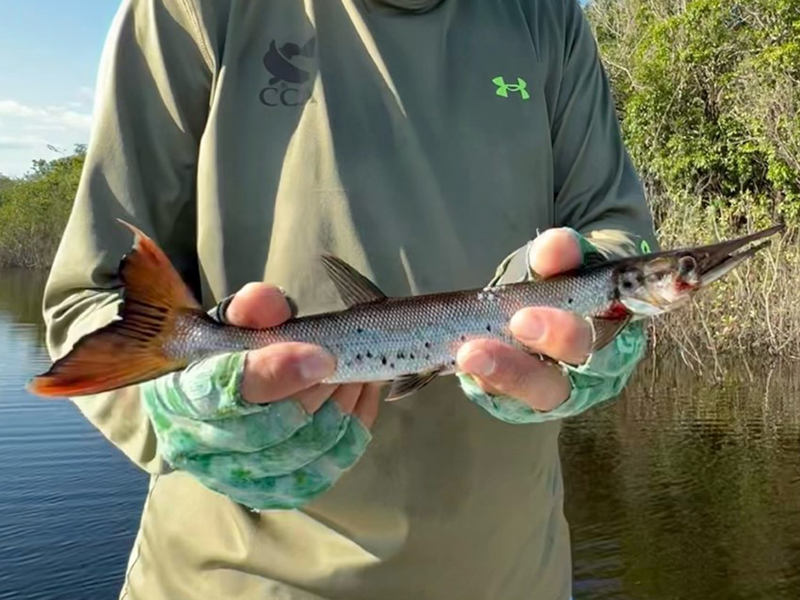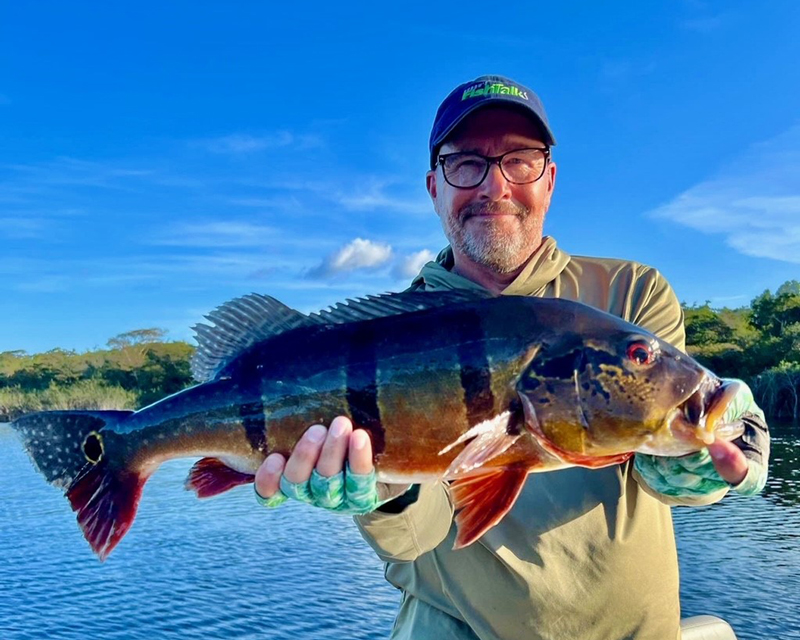It’s December at home in Solomons, MD, but it’s spring here in the southern hemisphere and time for an adventure fishing in Brazil. I’ve traveled for over 24 hours and journeyed more than 6000 miles to fish the Rio Negro. We arrived at 9 a.m. in the morning, flying into an airport just outside of Barcelós, Brazil in the state of Amazonia. I’m in Brazil as part of a 10-day Amazon fishing press trip. Our first stop is the city of Manaus, where the Solimões and the Rio Negro Rivers converge. This is known as the Meeting of the Waters. The two rivers run next to each other for almost four miles before they become the great Amazon River. They are unable to mix where they meet due to their differences in speed, temperature, and sediment.

I find myself standing on the bow of a Nitro Bass boat, nearly blinded by the refection of the sun off the water. The air temperature is in the high 80s and the humidity is hovering around 87 percent. Our guide drags his hand through the cool water of the Rio Negro, then wets his steering wheel to protect himself from the intense heat before he takes hold. Speaking in broken English and making a circular motion with his hands, he tells me and my fishing partner Rob to reel ’em in. Portuguese is the main language in Brazil, though many of the guides, including ours, speak just enough English to get you through the day.
We’ve been casting topwater baits on seven-foot medium- to heavy-action rods for about 40 minutes or so without any luck. The rods are married with baitcast reels that have a gear ratio greater than 7.01:1, carry 65- to 80-pound braid, and a 30- to 50-pound leader attached with an FG knot. With each cast I fear that I’ll run out of line as I can start to see the reel’s spool right before my bait hits the water. My thought is that the braid line that they have put on my reel is too heavy. Soon I’ll find out why we need such heavy gear.
We cast bright six-inch rear-spinner topwater baits, let them settle, then give a quick pull down of the rod tip toward the water’s surface. The bait jerks and makes a large splash from its rear spinner. Then three quick turns of the handle, and repeat: jerk-reel-jerk in quick succession. “Faster, faster!” instructs our guide. The sun continues to beat down.
Unfortunately, fishing is tough because the river is almost 10 feet above normal for this time of year. From May through July the river will have risen yet another 80 feet, when it reaches the city of Manaus. We are told to “fish in the jungle,” meaning we are to cast as far back into the brush and trees as possible. But no worries if you get hung up in there; the guide will just ask if you’re fishing for monkeys.
We change tactics, tying on jigs with a cornucopia of bright orange, red, yellow, and black. We cast out and troll the jigs, make two quick snaps of the rod tip, then let the bait drop back before repeating the motion. “Faster!” our guide insists.
Then Rob gets bit. It’s a big fish and the fight is on — drag is screaming and his line is spooling off his reel. The fish takes control and gets tangled in a submerged tree along the shoreline. Our guide brings the boat alongside the fish using the trolling motor. Grabbing the lip-grippers he rushes to the side of the boat nearest the fish, drops his ball cap on the deck, goes right over the side, and disappears below the tannic colored water of the Rio Negro. Snapping off tree limbs with one hand and grabbing the leader with the other, the fish jumps out of the water and over the top of his head! The guide loses the fish-grippers to the depths of the Rio Negro, but now that it’s out of the tree Rob gets the fish under control and pulls the massive peacock bass toward the boat so I can scoop with the net and bring it onboard. Victory!
Meanwhile, our guide pulls himself over the gunnel and out of the piranha-infested water. Yeah, you heard me right, piranha are as common in the rivers of the Amazon basin as bluegill are in North American waters.

After a few quick photographs Rob releases the fish, we troll on, and it’s no more than a few moments before I’m hooked up. The pull isn’t anything near what Rob experienced and I work the fish back to the boat to discover it’s a small bicuda, a pike-like fish. I get a quick photo then release the fish unharmed — but it’s not long before I get bit again. This time the fish pulls hard and there are a few seconds of fight before it comes unbuttoned.
My disappointment continues.
Rob’s next up on a bite. It’s a small black piranha with teeth are sharp as razors. They are a relatively safe fish as long as you don’t get your hand close to its mouth. If you know anything about a bluefish bite, think of the same but slightly more dangerous. As we troll we change out our jigs on occasion because piranha bite the bucktail end off the jigs, leaving nothing but a stump of hair.
Then the jig I’m trolling comes to an abrupt stop. The tip of my rod bends hard and drag starts stripping off. I place my thumb on the spool of the reel to slow the fish, and feel the burn of the braid line. The fish turns — now I have control. I fight the fish up to the net and although it’s not as big as Rob’s, I’m elated. I’ve caught a peacock bass in the Amazon River.

Now, I understand why they use this type of gear to catch and land these majestic fish. They are strong, hard fighters living in an environment of flooded timber and rock.
Our next day of fishing took us to an outpost nearly 75 miles up the Aracá River, over 18 miles south of the equator. The sun is just as intense here. And during the next two days we catch butterfly peacock bass, three-barred peacock bass, bicuda, piranha, and wolf fish.
At four o’clock in the afternoon a few days later I land, utterly exhausted, in Miami. I have a layover for a few hours before the flight to Baltimore and then a two-hour drive home, so it won’t be until tomorrow that I can reset my fishing focus on millponds and pickerel. I want — no I need — a hamburger and fries, items not on the menu in Brazil. I find a Wendy’s and order the all-American meal. As I sip my soda, I drift off a bit, feel the sun on my back, and take one more cast into the jungle.
What You Need to Know for Fishing in Brazil
Seasons on the Amazon
The season for peacock bass runs from August to early March. I’m told the best months are usually September and October. The outfitter and the time of year dictate where you may be fishing, and as the water levels start to rise at the beginning of the rainy season in December, some outfitters move to find shallower water to fish.
Travel and Accommodations
If you book a trip to fish in Amazonia you can find direct flights from Miami or Fort Lauderdale to Manaus, and complete the trip in about half the time it took me. I had a long nine-hour layover in Miami because I was meeting up with five people coming from different parts of the nation, and then we passed through Brasilia, adding almost seven additional hours of travel.
The accommodations in Brazil were very nice. The hotel that we stayed in in Manaus was excellent, with a pool on the roof, a small bar, and a nice restaurant. Accommodations at the fishing lodge in Barcelos provided a lounge, restaurant, and bar. Rooms had a small refrigerator and bath with shower. They were comfortable and clean. However, the outpost was my favorite! There were two screened-in thatched roof buildings, each with two suites that sleep four persons each, a bathroom, sink, and shower. Don’t be surprised if you take a shower in the morning and the water is cold — it’s pumped up from the river to a water tower where sun heats it during the day, so take your showers in the evening.
DO NOT brush your teeth or drink the water out of the sinks while traveling in the remote regions of the Amazon. They provide plenty of bottled water, so brush your teeth with the bottle water provided.
Food in Brazil
The local food is great! I loved every meal and by the way, beef is always on the menu. A local Brazilian treat is a staple: farofa, made with toasted cassava flower. It is a starch that is served similar to how rice is served here in the states.
Finding an Outfitter for Fishing in Brazil
Our outfitter was Personal Fishing, which has the lodge on the Negro River in Barcelos, Brazil. Fixed location lodges have the disadvantage of not being able to follow the seasons, and while the fishing can still be great some outfitters use floating lodges such as the one we also fished from, Zaltana. They are a mother ship with guest rooms, a restaurant, lounge, and a fleet of bass boats.
You can find out more about fishing Amazonia by going to Visit Brazil.